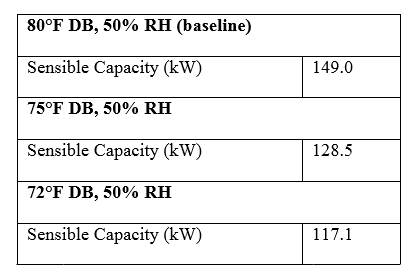Todd Boucher is the Principal and Founder of Leading Edge Design Group (@ledesigngroup), a critical infrastructure firm that specializes in designing, building, and maintaining Data Center, LED Lighting, and Information and Communications Technology systems.
A challenge for data center customers is finding a way to leverage existing cooling infrastructure to support ongoing technology upgrades. As technology is refreshed, consolidated, and virtualized, per rack density (in kilowatt, or kW per rack) increases and the capacity of legacy cooling infrastructure is often reached or exceeded.
For example, a legacy data center is typically configured with a raised floor and perimeter Computer Room Air Conditioner (CRAC) units. The CRAC units are downflow – supplying cool air down into the raised floor plenum – with an open return. In general, this design could effectively support an average of 3kW per rack of IT load. In today’s data center, technology requirements are driving per rack densities far beyond 3kW per rack and customers are seeking an effective way to support their technology upgrades without a major data center renovation.
Data Center Aisle Containment has emerged as an effective strategy for increasing an existing data center’s capacity to support higher density rack loads. The issue for many customers is determining how to implement aisle containment in their data center and what product, strategy, and project plan are right for them. Vendors of aisle containment systems can offer advice, but customers are concerned that this is limited to the product set that the vendor can provide.
Evaluating Aisle Containment Solutions
A persistent discussion in the data center industry is arguing the benefits of hot aisle containment systems (HACS) versus cold aisle containment systems (CACS). The reality is that both containment strategies are effective. Customers need to first understand the characteristics of their existing facility and then use that profile to determine the right aisle containment strategy for their environment.
Understand the Importance of Return Air Temperature
The primary function of aisle containment is to physically separate the air streams in the data center, ensuring that cool supply air is delivered to the IT equipment inlet (cold aisle) without mixing with the hot IT equipment exhaust air (hot aisle)3. Creating this separation will help eliminate hot spots and improve the consistency of supply temperature across the vertical face of the IT enclosure.
More importantly, separating data center air streams with aisle containment systems can increase the usable capacity of your CRAC units. A common mistake data center operators make is assuming that a 30-ton CRAC unit is providing 30 tons of usable capacity in the data center. In most existing data centers, the usable capacity of a CRAC unit (actual cooling capacity being delivered) is reduced due to the return air temperature being returned to the CRAC unit. In other words, you can only expect to get 30 tons of usable capacity at specific design conditions. Examining the capacity data for a chilled water CRAC unit illustrates this reduction:
Sample CRAC Unit Capacity Data (Based on 45°F Entering Water)
As you can see, the full capacity of the sample CRAC unit (149kW) is achieved when 80°F return air is returned to the CRAC unit. However, if that return air temperature is reduced by 5°F, the output of the CRAC unit decreases by 15 percent. If the return air temperature is decreased by 8°F, the capacity of the CRAC unit decreases by 24 percent.
By implementing aisle containment, we can increase the return air temperature to data center CRAC units, thus increasing the usable cooling capacity in the data center space. Before evaluating aisle containment, it is important for data center operators to measure their existing return temperature conditions; it will provide a perspective on the operation of their current cooling system and provide a critical benchmark to improve upon through an aisle containment implementation.
Evaluate your Rack/Row Orientation and Profile
The existing rack/row orientation in your data center and its symmetry will dictate the complexity of implementing aisle containment. For example, if you have a homogenous data center with a standardized rack profile, you will have a number of options for aisle containment systems. The likelihood that these solutions will be “out-of-the-box” from aisle containment vendors is high. However, if you have a more heterogeneous data center with varying rack heights, depths, and widths, it is important to understand that more customization will be required. This is especially true if your data center rack footprint is fixed (i.e., rack locations cannot be adjusted for greater symmetry).
Data center owners should understand which rack/row profile their data center falls into prior to beginning the aisle containment evaluation process. If your data center has a heterogeneous rack profile, it is important to determine how much (if any) footprint reconfiguration you are willing to undertake to support a containment project. Providing this information to prospective vendors will ensure that you receive system proposals that are accurate and able to be implemented in your current data center environment.
Aisle containment implementations offer significant benefits to data center operators looking to support higher density IT equipment, regain capacity from their cooling system, and extend the lifecycle of their existing facility. Hot Aisle Containment Systems (HACS) and Cold Aisle Containment Systems (CACS) are both effective strategies; the correct aisle containment solution for a customer’s data center should be developed through a detailed review of the customer’s requirements and existing data center conditions.
Read Part Two of This Article.
Industry Perspectives is a content channel at Data Center Knowledge highlighting thought leadership in the data center arena. See our guidelines and submission process for information on participating. View previously published Industry Perspectives in our Knowledge Library.






